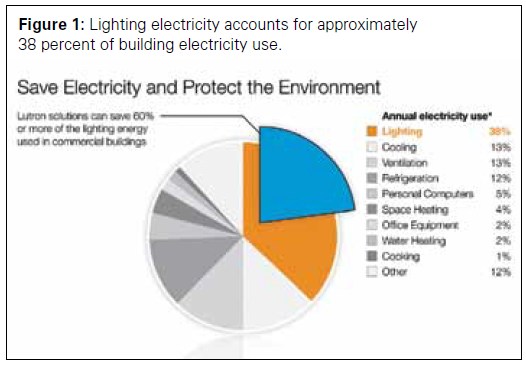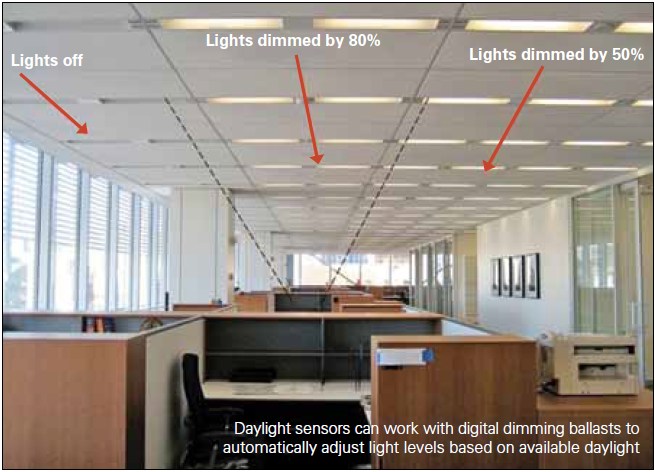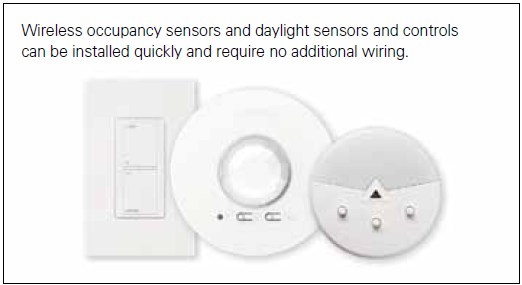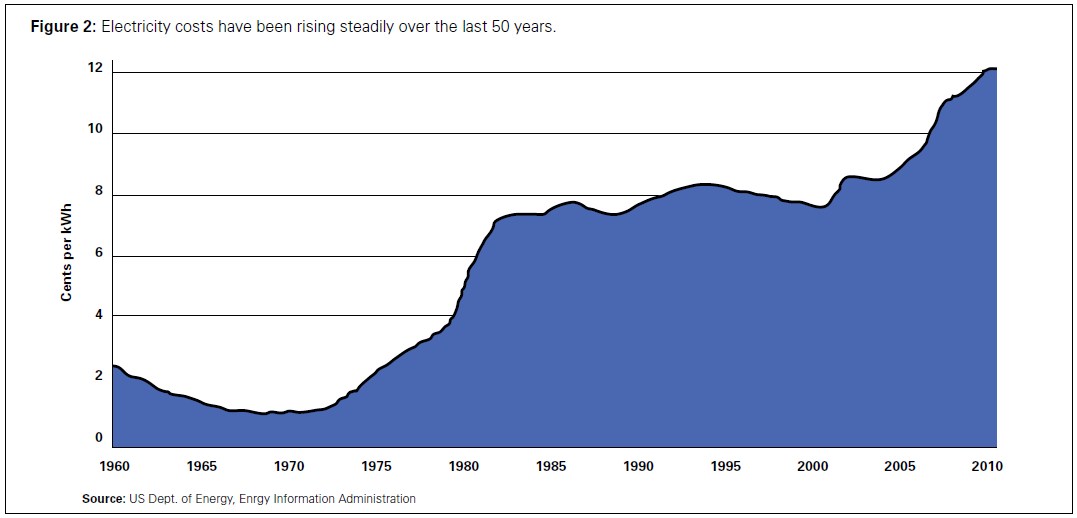by Brian Dauskurdas — There are 71 billion square feet (6.6 billion square meters) of commercial building space in the U.S., and more than 90 percent of it was built in the last century.1 Making these buildings more efficient and more sustainable is becoming a top priority for building owners, management companies and tenants across the country. Local and federal codes mandate new energy standards; rising electricity costs drive facilities to reduce electricity use; and building owners are embracing the idea that efficient buildings can command higher rent, facilitate longer leases, limit tenant turn-over and reduce building operating costs.
Lighting accounts for approximately 38 percent of the average commercial office building’s total electricity use, which means that effectively managing lighting use can have a huge impact on a building’s energy costs1 (see Figure 1). In new construction, sustainable building practices are becoming the norm, but even in existing buildings simple strategies can be implemented quickly and easily to address inefficiencies, reduce energy use, improve comfort and enhance productivity in the space. Three of the most common contributors to lighting electricity waste in buildings include spaces that are over-lit, lights that are left on 100 percent of the time and spaces that do not make adequate use of daylight.
In spaces that are frequently over-lit, digital dimming ballasts can reduce maximum light levels in a space by 20 percent or more — a strategy called high-end trim or institutional tuning. Because the human eye readily adapts to slight variations in ambient light, those changes are virtually undetectable to occupants. High-end trim typically saves 15-20 percent lighting electricity.2

Occupancy/vacancy sensors ensure that lights are not left on when a space is vacant, generally saving an additional 30 percent.3 In perimeter spaces, daylight sensors can automatically adjust light levels based on the amount of daylight in the space. Daylight harvesting can contribute 20-60 percent lighting energy savings,4 and like high-end trim, because lights adjust over a few seconds, the change is generally transparent to the people in the space.
Another ideal space for occupancy sensors is stairwells. Mike Hodowanec, Purchasing Manager for the Reading Area Community College in Reading, Pa., describes how wireless occupancy sensors communicate with retrofit, field-adjustable stairwell fixtures to save significant lighting energy in his facility.
“We installed the retrofit solution in 11 stairwells on our campus and then programmed these fixtures to deliver a highend light level of 60 percent for an occupied stairwell and a 10 percent low-end light level for an unoccupied stairwell, which still exceeds minimum code requirements,” he said. “Our initial analysis indicates lighting energy savings of between 80 and 82 percent as a result of the new lighting control solution.”
Recently, as part of a sustainable building retrofit program, the Empire State Building in New York City incorporated these simple lighting control strategies throughout its prebuilt tenant spaces. The building is committed to reducing overall energy use in its facility by 38 percent. The installed lighting controls are expected to reduce lighting electricity use alone by 65 percent,5 with a payback of 2.75 years6 — making a significant impact on the building’s overall energy-reduction goals.
Having identified some basic strategies for managing lighting energy use in retrofit applications, it is useful to understand specific market trends driving the implementation of lighting control strategies and combating lighting energy waste.
- Stronger codes and standards
- Federal mandates
- The rising cost of electricity
- Payback and ROI considerations
Stronger Codes and Standards
Energy codes and standards vary by state, but all of the nation’s top energy codes reflect the importance of using lighting controls to conserve energy. Most U.S. states, with the exception of California, which uses its own stringent Title 24 standard, currently use the standards established by the American Society of Heating, Refrigerating, and Air-Conditioning Engineers (ASHRAE 90-1-2007), or those established by the International Energy Conservation Code (IECC).

On October 19, 2011, the U.S. Department of Energy issued a ruling that requires all states to certify that they have updated the provisions of their commercial building code regarding energy efficiency, to meet or exceed ASHRAE 90.1-2010 Standard by October 18, 2013.
As part of its revised code, ASHRAE 90.1-2010 also requires that if more than 10 percent of the lighting load is altered in a space (i.e. at least both the lamps and ballasts are changed), all the lighting in the space must comply with automatic shut-off and lighting power density requirements. Essentially, when a facility is replacing any significant number of fixtures, it makes economic and practical sense to include lighting control at that time. By choosing a lighting control system that incorporates digital dimming ballasts and wireless controls, you can minimize labor and materials costs, while enabling your building to increase energy savings and realize a more attractive ROI.
The following are some of the minimum lighting control requirements that have been adopted by at least one of the three major building energy codes/standards (ASHRAE 90.1-2010, IECC 2012 and Title 24 2008). These minimum requirements apply to both new construction and renovation or alteration of building lighting.
- Area control. Each area enclosed by ceiling-height partitions must have an accessible, independent switching or control device (such as an occupancy sensor, manual switch, or dimmer) to control the general lighting.
- Automatic shut-off. All indoor lighting systems must include a separate automatic shut-off control, such as an occupancy sensor or time switch. A wireless occupancy sensor, featuring patented technology to limit interference and ensure that occupants will never be left in the dark, can be installed in minutes and reduce installation costs in building retrofits.
- Daylight zone control. Areas in daylight zones* shall have a separate control for the general lighting.** Typically, a daylight sensor and dimming ballasts that control at least half of the general lighting power meet this requirement. Switched daylight control also complies with code but is more disruptive to occupants. By utilizing digital dimming ballasts that communicate wirelessly with automatic dimming controls and wireless daylight sensors, electric light can be effectively used as a complement to available daylight without compromising appropriate light levels.
- Functional testing. Prior to inspection, lighting controls must be tested to ensure they are working properly. Building owners and managers can select lighting controls from a manufacturer that tests every product before it is shipped out to the customer, limiting issues during installation and reducing the chance of delays during building inspection.
- Light reduction controls. Most spaces must allow the occupants to select a lighting level that is between 30 and 70 percent of full power (at least 50 percent or lower for IECC) in addition to OFF by either continuous dimming, stepped dimming (dimming lights to certain, pre-defined, light levels) or stepped switching (separately switching alternate lamps in a fixture or alternate luminaires in a space) while maintaining a reasonably uniform level of illumination throughout the controlled area. Personal dimming controls will allow the occupants to choose the level of light appropriate for the work they are doing. Digital ballast technologies allow fixtures to respond individually, or as a group, to ensure the right light levels for the space and also enable these fixtures to be quickly and easily reprogrammed without rewiring or expensive software changes in the event of changes to the space.
- Occupancy sensor or timer switch controls. Occupancy sensors that turn off lighting within 30 minutes of vacancy are required in spaces such as, but not limited to:
- Classrooms and lecture halls
- Conference, meeting and training rooms
- Employee lunch and break rooms
- Storage and supply rooms

Wireless controls make it easy to add occupancy/vacancy sensors to any space without additional wiring or complex programming.
- Stairwell controls. Lighting in enclosed stairwells shall have one or more control devices to automatically reduce lighting power by at least 50 percent within 30 minutes of vacancy. Select a stairwell fixture solution that communicates with a wireless occupancy sensor and features adjustable high- and low-end light levels to ensure lights come on to a predetermined light level when the space is occupied and return to a minimum level when it is unoccupied. Stairwells are used rarely, or only in emergencies, and energy savings of 80 percent can be achieved with an occupancy-sensing lighting control solution.
Federal Mandates
In addition to building codes, federal mandates are changing the landscape of the commercial lighting environment. As of June 2012, federal mandates prohibit the manufacture or import of old-style T12 fluorescent lamps. Fluorescent light fixtures are the predominant light source in commercial buildings, and as many as 500 million T12 lamps are estimated to be in use today. All of these lamps will have to be replaced with more efficient T8 or T5 lamps and electronic ballasts within the next few years.
When a property owner is required to invest in fixture upgrades to accommodate this mandate, it makes sense to invest a little more up front to realize significant lighting electricity savings over the long term. Reducing lighting electricity use also minimizes heat gain and can contribute additional HVAC savings. Combined with potential cost savings from local and federal rebates and savings realized as the actual cost of electricity rises, a digital dimming solution is often the lowest cost, most sustainable option in commercial lighting retrofit applications.
Commercial electricity prices have been steadily rising for the last 50 years and are generally up an average of 20 percent in just the last five years (see Figure 2). There is very little the end user can do to reduce the actual cost of electricity, but a digital, wireless lighting controls solution helps ensure that it is easier to manage lighting operating costs as prices rise. By choosing a solution designed to work with any light source, as more efficient light sources are introduced to the market, the building will be able to incorporate those new technologies without having to replace the entire lighting control system.
Payback and ROI
If a building currently relies on manual controls to switch light fixtures, investing in a lighting control system that incorporates automatic control strategies will typically deliver lighting electricity savings of 60 percent.5 A lighting control system can provide even greater savings in areas like stairwells and restrooms that are often used only intermittently but are required by code to be illuminated 100 percent of the time. In these spaces, a dimming solution that incorporates occupancy sensors can ensure that lighting is dimmed to minimum levels when the space is vacant and automatically increased to a preset level as soon as the space becomes occupied, achieving energy savings of up to 80 percent.7 Energy rebates are available in many areas to offset the cost of materials and labor, and a three-year ROI can be expected with the appropriate system.

Other Considerations
It is important to keep long-term goals in mind when you are selecting a lighting control solution for a building retrofit or renovation. Choose a manufacturer with a proven record of product innovation, customer support and high quality. Look for digital, wireless solutions that can easily be adjusted and reprogrammed to accommodate new building occupants or adapt to different tasks and users in the space. Occupancy sensors should feature technology that reliably detects both fine motion and major movement to ensure that no occupant is ever left in the dark. Wireless communication protocols should ensure that the installed lighting control products communicate clearly and without interference or flicker regardless of other technologies in the space.
Simple retrofit lighting control solutions can be installed quickly and easily, especially when they are included as part of an essential fixture retrofit. The right solutions will make your building more efficient, help meet building code requirements, provide greater control to the occupants in a space and deliver enhanced value to the building owner.
Editor’s Note:
CoreNet Global advocates energy management and conservation as socially responsible corporate practices. You can find more information at www.corenetglobal.org.
Sources:
1Energy Information Administration, 2003 Commercial Buildings Energy
Consumption Survey. Building Characteristics Tables, released December
2006. Retrieved from http://www.eia.gov/emeu/cbecs/cbecs2003/detailed_
tables_2003/2003set1/2003pdf/a1.pdf.
2Williams A, et al. 2012. Lighting Controls in Commercial Buildings. Leukos. 8(3) pg 161-180.
3VonNieda B, Maniccia D, & Tweed A. 2000. An analysis of the energy and cost savings potential of occupancy sensors for commercial lighting systems.
Proceedings of the Illuminating Engineering Society. Paper #43.
4Brambley MR, et al. 2005. Advanced sensors and controls for building applications:
Market assessment and potential R&D pathways. Pacific Northwest
National Laboratory: prepared for U.S. Department of Energy.
5Compared with manual (non-automated) controls, up to 65% lighting energy savings is possible on projects that utilize all of the lighting control strategies used by Lutron in the Empire State Building project (occupancy sensing, highend trim, and daylight harvesting). Actual energy savings may vary, depending on prior occupant usage, among other factors.
6Estimates based on Lutron controls installed in Empire State Building prebuilt
tenant space. Payback claims assume 65% reduction in energy costs, and
energy rates of 22 cents per kWh. Actual payback terms may vary.
7Reading Area Community College Case Study, December 2011. Retrieved
from http://www.lutron.com/Residential-Commercial-Solutions/SolApp/Education/College/racc/Documents/3672264_Project_Overview_RACC_d.pdf. Savings assumes the replacement .of a 2 lamp 40W T12 stairwell fixture
at full output for 8760 hours with a 2 lamp 32W T8 fixture at 50% output for
2190 hours and 10% output for 6570 hours.
*Daylight zones are typically one window height (distance from top of window
to the floor) into the space and the width of the window, plus two feet on both
sides of the window.
** General lighting is lighting that provides a substantially uniform level of
illumination.
About the Author

Brian Dauskurdas, Director of Total Building Solutions for Lutron Electronics, is in charge of the company’s Global Energy Sales Team, which
is focused on leading the company’s growth into existing building retrofits. He sits on Chicago’s Construction and Real Estate Council and is an advisor to RealComm’s Intelligent Building Council.